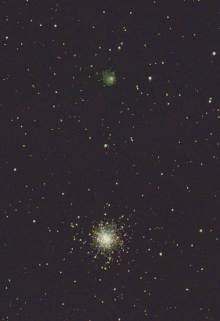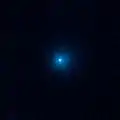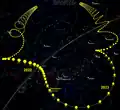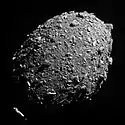C/2017 K2 (PanSTARRS)
C/2017 K2 (PanSTARRS) is an Oort cloud comet with an inbound hyperbolic orbit, discovered in May 2017 at a distance beyond the orbit of Saturn when it was 16 AU (2.4 billion km) from the Sun. Precovery images from 2013 were located by July.[7] It had been in the constellation of Draco from July 2007 until August 2020. As of June 2022, the 3-sigma uncertainty in the current distance of the comet from the Sun is ±6000 km.[8]
 Time-lapse with an 8" Celestron telescope on July 14, 2022 - the night of its closest approach to Earth. Below the comet is the Globular Cluster Messier 10. | |
| Discovery | |
|---|---|
| Discovery date | 21 May 2017[1] |
| Orbital characteristics | |
| Epoch | 2022-12-07 (2459920.5) |
| Observation arc | 9.46 years |
| Number of observations | 477 |
| Orbit type | Oort cloud |
| Aphelion | ~50000 AU (inbound)[2] ~1400 AU (outbound)[2] |
| Perihelion | 1.7969 AU[3] |
| Eccentricity | ~0.99992 (inbound) ~0.9975 (outbound)[2] |
| Orbital period | Millions of years inbound[2] ~19,000 years (outbound)[2] |
| Inclination | 87.563° |
| 88.26730 | |
| Last perihelion | 19 December 2022[3][4][lower-alpha 1] |
| Earth MOID | 1.10 AU (165 million km) |
| Jupiter MOID | 1.29 AU |
| Physical characteristics | |
| Dimensions | Rn between 14 km (8.7 mi) and 80 km (50 mi)[5] maximum Dn ~18 km (11 mi)[6] |
The comet is record breaking because it was already becoming active at such a distance. Only Comet Hale–Bopp produced such a show from that distance with a similar nucleus. However, this comet will not be as visible as Hale–Bopp was in 1997 in part because it does not come nearly as close to the Sun.[lower-alpha 2] Astronomers had never seen an active inbound comet this far out, where sunlight is 1/225th its brightness as seen from Earth. Temperatures, correspondingly, are at -440 °F (-262 °C) in the Oort cloud. However, as it was approaching the Sun at a distance of 16 AU at discovery, a mix of ancient ices on the surface containing oxygen, nitrogen, carbon dioxide and carbon monoxide began to sublimate and shed the dust frozen into it. This material expands into a vast 130,000 km (81,000 mi) wide halo of dust, called a coma, enveloping the solid nucleus.[9] Outgasing of carbon monoxide was detected when the comet was 6.72 AU from the Sun.[10]
Research with the Canada–France–Hawaii Telescope (CFHT) infers the comet nucleus to have a radius between 14–80 km (9–50 mi), so there is a chance the nucleus could be as large as C/1995 O1 (Hale-Bopp).[5] However, research with the Hubble Space Telescope (HST) estimates the nucleus to have a circular equivalent diameter of less than 18 km (11 mi).[6] On 17 September 2020, morphological studies of the inner coma, observed on 12 September 2020, were reported, noting that two jet-streamed structure were emitted from the nucleus and, as well, that the length of the tail was about 800,000 km (500,000 mi) long.[11]
The comet was within 5 AU (750 million km) of Earth by 11 January 2022.[12] Around 6 July 2022, the comet crossed the celestial equator, and then on 14 July 2022, it passed 1.8 AU (270 million km) from Earth[13] and shone around 9.0 magnitude making it a decent binoculars object.[14][4] It reached perihelion on 19 December 2022, close to the orbit of Mars, and was not be visible to naked eye at 8.0 magnitude.[3][4][lower-alpha 1]
On 27 July 2021, further detailed observations of the comet were reported on The Astronomer's Telegram.[15][16]
JPL Horizons models that C/2017 K2 took millions of years to come from the Oort cloud at a distance of roughly 50,000 AU (0.8 ly).[2] The heliocentric orbital eccentricity drops below 1 in December 2023.[17] The outbound orbital period will be around 19000 years with aphelion being around 1400 AU.[2] There was a dispute whether that was the first time the comet entered the inner solar system, but its orbit suggests that the comet isn't dynamically new and there is a 29% chance that the comet is of interstellar origin and was captured in the solar system the last 3 million years.[18]
Gallery
 June 2017 by Hubble's Wide Field Camera 3[19]
June 2017 by Hubble's Wide Field Camera 3[19]_with_M10.jpg.webp) 11" fast Astrograph on 2022-07-16 while near Messier 10
11" fast Astrograph on 2022-07-16 while near Messier 10 Path of C/2017 K2 in the sky
Path of C/2017 K2 in the sky
References
- "MPEC 2017-K35 : COMET C/2017 K2 (PANSTARRS)". IAU Minor Planet Center. 2017-05-24. Retrieved 2017-10-21. (CK17K020) (2.6 day observation arc with perihelion estimated to be in 2027)
- Horizons output. "Barycentric Osculating Orbital Elements for Comet C/2017 K2 (PANSTARRS)". Solution using the Solar System Barycenter. Ephemeris Type:Elements and Center:@0 (To be outside planetary region, inbound epoch 1950 and outbound epoch 2050. For epoch 2050-Jan-01 orbit period is "PR= 6.58E+06 / 365.25 days" = ~18,000 years)
- "C/2017 K2 (PANSTARRS) Orbit". Minor Planet Center. Archived from the original on 2017-11-13. Retrieved 2017-11-13.
- Seiichi Yoshida. "C/2017 K2 ( PanSTARRS )". Seiichi Yoshida's Comet Catalog. Retrieved 2020-06-02.
- Meech, Karen (2017). "CO-Driven Activity in Comet C/2017 K2 (PANSTARRS)". The Astrophysical Journal Letters. 849 (1): L8. arXiv:1710.03876. Bibcode:2017ApJ...849L...8M. doi:10.3847/2041-8213/aa921f. S2CID 119214098.
- Jewitt, David (2017). "A Comet Active Beyond the Crystallization Zone". The Astrophysical Journal. 847 (2): L19. arXiv:1709.10079. Bibcode:2017ApJ...847L..19J. doi:10.3847/2041-8213/aa88b4. S2CID 119347880.
- "MPEC 2017-N26 : COMET C/2017 K2 (PANSTARRS)". IAU Minor Planet Center. 2017-07-01. Retrieved 2017-10-21.
- Horizons output. "Current distance from the Sun with 3-sigma uncertainty in km".
- Byrd, Deborah (2 October 2017). "Farthest active inbound comet yet". Earth & Sky. Retrieved 19 September 2020.
- Yang, Bin; Jewitt, David; Zhao, Yuhui; Jiang, Xuejian; Ye, Quanzhi; Chen, Ying-Tung (10 June 2021). "Discovery of Carbon Monoxide in Distant Comet C/2017 K2 (PANSTARRS)". The Astrophysical Journal Letters. 914: L17. arXiv:2105.10986. doi:10.3847/2041-8213/ac03b7. S2CID 235166808.
- Manzini, Federico; et al. (17 September 2020). "ATel #14026: Morphological structures in the inner coma of comet C/2017 K2 (PanStarrs)". The Astronomer's Telegram. Retrieved 19 September 2020.
- "5au from Earth". JPL Horizons. Retrieved 2022-01-07.
- "Closest Approach to Earth in July 2022 (3 hour interval)" (Closest Earth approach occurs when deldot flips from negative to positive). JPL Horizons. Archived from the original on 2022-06-22. Retrieved 2022-06-21.
- Hubble Spots Farthest-Ever Incoming Active Comet September 29, 2017
- Manzini, Federico; et al. (27 July 2021). "ATel #14813: Comet C/2017 K2 (PanStarrs) shows jet-shaped dust emissions modulated by extremely slow rotation at greater-than-usual distance from the Sun". The Astronomer's Telegram. Retrieved 28 July 2021.
- Manzini, Federico; et al. (27 July 2021). "ATel #14814: Erratum to ATEL #14813: Comet C/2017 K2 (PanStarrs) shows jet-shaped dust emissions modulated by extremely slow rotation at greater-than-usual distance from the Sun". The Astronomer's Telegram. Retrieved 28 July 2021.
- Horizons output. "Heliocentric Osculating Orbital Elements for Comet C/2017 K2 (PANSTARRS) dropping below 1.0".
- Marcos, Raúl de la Fuente; Marcos, Carlos de la Fuente (24 April 2018). "Comet C/2017 K2 (PANSTARRS): Dynamically Old or New?". Research Notes of the AAS. 2 (2): 10. arXiv:1804.07292. doi:10.3847/2515-5172/aabf8f. S2CID 118938922.
- "Distant active comet C/2017 K2". www.spacetelescope.org. Retrieved 3 October 2017.
Notes
- Perihelion passage: Upon discovery perihelion was still 5 years away. An epoch of 2022 gives a more accurate perihelion date that properly accounts for planetary perturbations. An epoch 2017 unperturbed two-body solution (Sun+comet) gives a date of 2022-Dec-21. Integrating the orbit with JPL Horizons which accounts for planetary perturbations gives a date of 2022-Dec-19. The Minor Planet Center's Epoch Dec 2022 solution also gives a date of 2022 Dec. 19
- Comet Hale–Bopp came to perihelion (inside the orbit of Earth) at 0.9 AU whereas C/2017 K2 only comes to perihelion (outside the orbit of Mars) at 1.79 AU.
External links
- C/2017 K2 (PANSTARRS) Taken by ALBERTO QUIJANO VODNIZA on August 9, 2022 @ PASTO,NARINO. COLOMBIA
- A Comet Active Beyond the Crystallization Zone
- MPEC 2017-K90 : COMET C/2017 K2 (PANSTARRS)
- NASA's Hubble Observes the Farthest Active Inbound Comet Yet Seen
- Note on the dynamical evolution of C/2017 K2 PANSTARRS (arXiv 2018)
- C/2017 K2 EarthSky July 12 2022
- C/2017 K2 (PANSTARRS) motion as seen by Catalina Sky Survey 22 August 2020

.png.webp)

